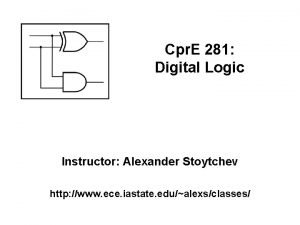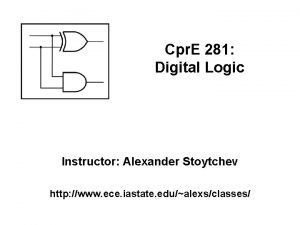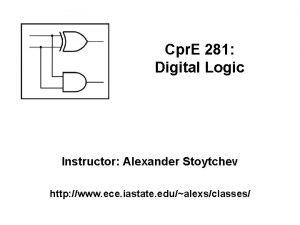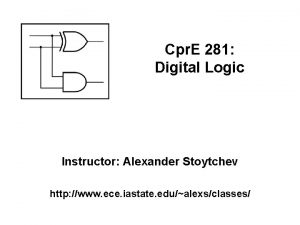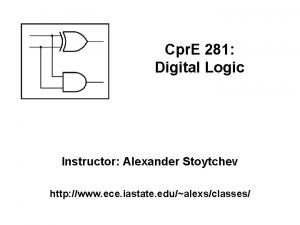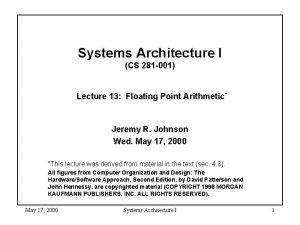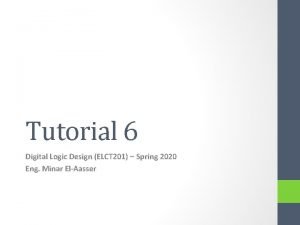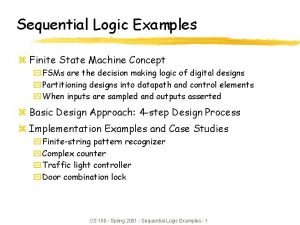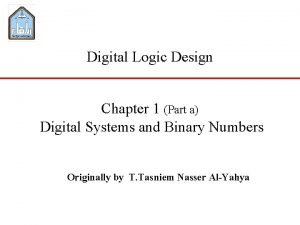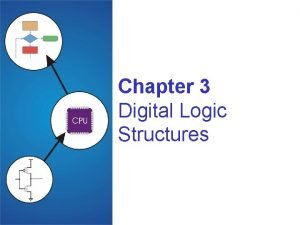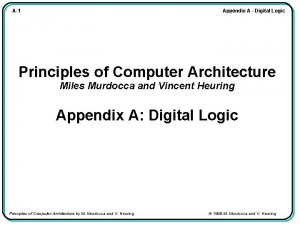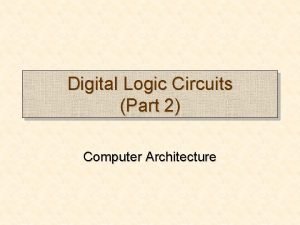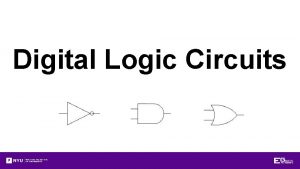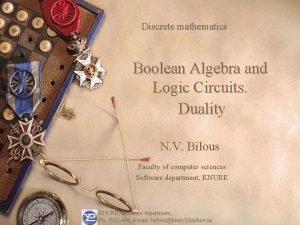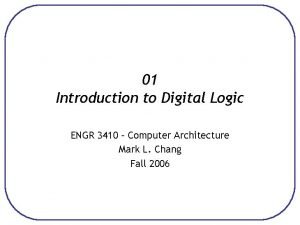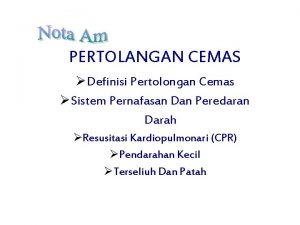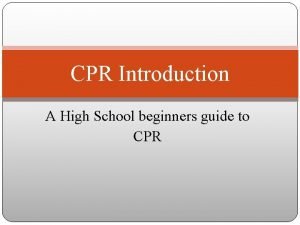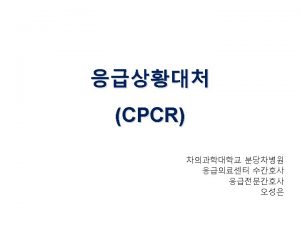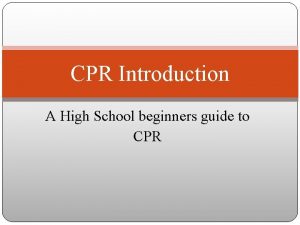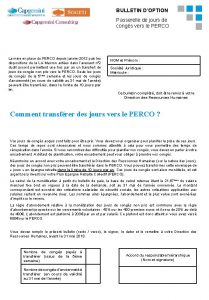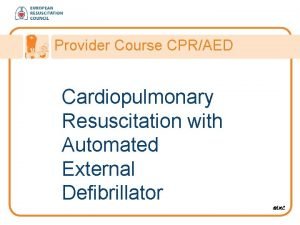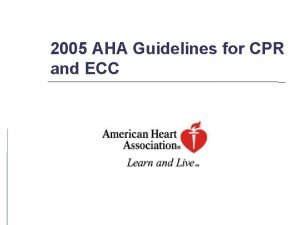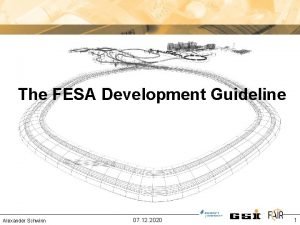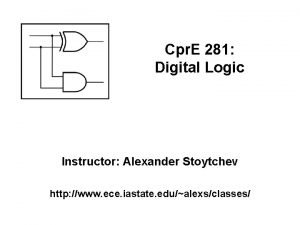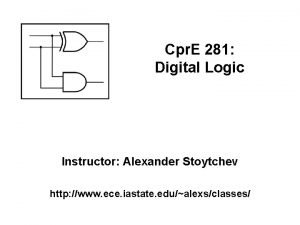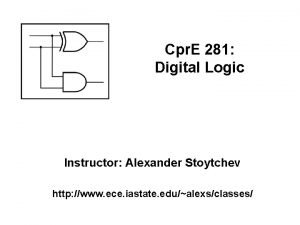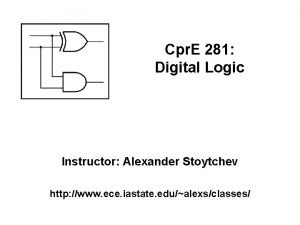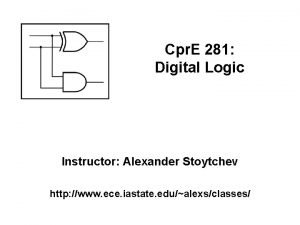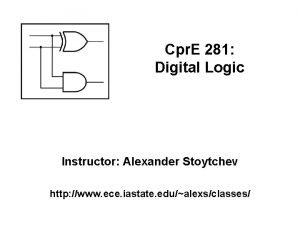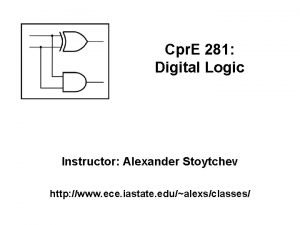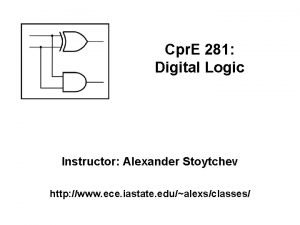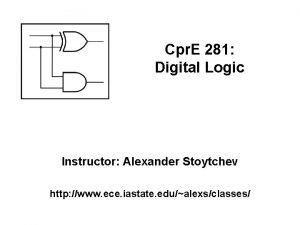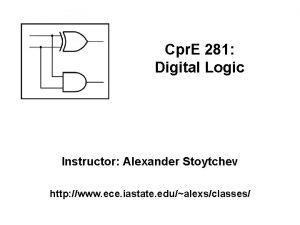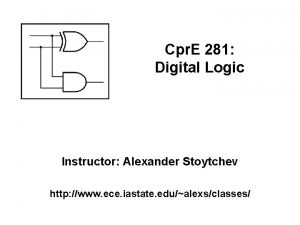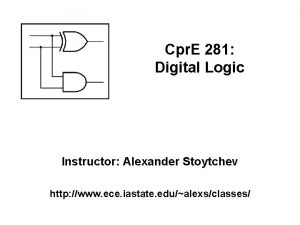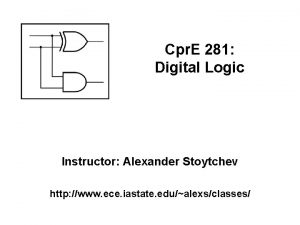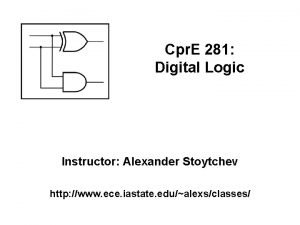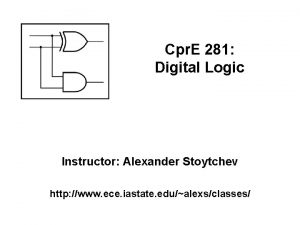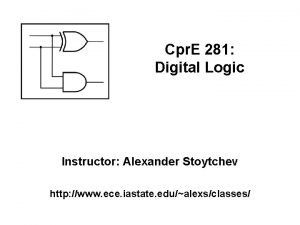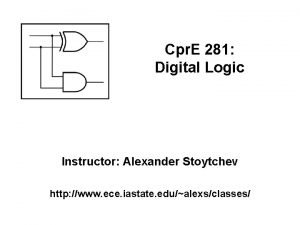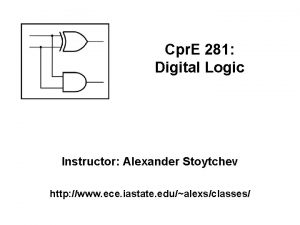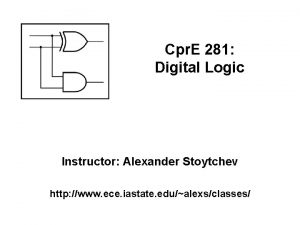Cpr E 281 Digital Logic Instructor Alexander Stoytchev
































![Gated D Latch: Alternative Design Clk [https: //en. wikipedia. org/wiki/Flip-flop_(electronics)] Gated D Latch: Alternative Design Clk [https: //en. wikipedia. org/wiki/Flip-flop_(electronics)]](https://slidetodoc.com/presentation_image/cd148757ba7f53130772b81cc8473905/image-33.jpg)















![T Flip-Flop [ Figure 5. 15 a from the textbook ] T Flip-Flop [ Figure 5. 15 a from the textbook ]](https://slidetodoc.com/presentation_image/cd148757ba7f53130772b81cc8473905/image-49.jpg)
![T Flip-Flop Positive-edge-triggered D Flip-Flop [ Figure 5. 15 a from the textbook ] T Flip-Flop Positive-edge-triggered D Flip-Flop [ Figure 5. 15 a from the textbook ]](https://slidetodoc.com/presentation_image/cd148757ba7f53130772b81cc8473905/image-50.jpg)
![T Flip-Flop What is this? [ Figure 5. 15 a from the textbook ] T Flip-Flop What is this? [ Figure 5. 15 a from the textbook ]](https://slidetodoc.com/presentation_image/cd148757ba7f53130772b81cc8473905/image-51.jpg)























































![Parallel-access shift register [ Figure 5. 18 from the textbook ] Parallel-access shift register [ Figure 5. 18 from the textbook ]](https://slidetodoc.com/presentation_image/cd148757ba7f53130772b81cc8473905/image-107.jpg)








































- Slides: 147

Cpr. E 281: Digital Logic Instructor: Alexander Stoytchev http: //www. ece. iastate. edu/~alexs/classes/

Registers Cpr. E 281: Digital Logic Iowa State University, Ames, IA Copyright © Alexander Stoytchev

Administrative Stuff • Homework 8 is due next Monday. • The second midterm exam is next Friday.

Administrative Stuff • Midterm Exam #2 • When: Friday October 27 @ 4 pm. • Where: This classroom • What: Chapters 1, 2, 3, 4 and 5. 1 -5. 8 • The exam will be open book and open notes (you can bring up to 3 pages of handwritten notes).

Midterm 2: Format • The exam will be out of 130 points • You need 95 points to get an A for this exam • It will be great if you can score more than 100 points. § but you can’t roll over your extra points

Midterm 2: Topics • • Binary Numbers and Hexadecimal Numbers 1’s complement and 2’s complement representation Addition and subtraction of binary numbers Circuits for adders and fast adders • Single and Double precision IEEE floating point formats • Converting a real number to the IEEE format • Converting a floating point number to base 10 • Multiplexers (circuits and function) • Synthesis of logic functions using multiplexers • Shannon’s Expansion Theorem

Midterm 2: Topics • • • Decoders (circuits and function) Demultiplexers Encoders (binary and priority) Code Converters K-maps for 2, 3, and 4 variables • Synthesis of logic circuits using adders, multiplexers, encoders, decoders, and basic logic gates • Synthesis of logic circuits given constraints on the available building blocks that you can use • Latches (circuits, behavior, timing diagrams) • Flip-Flops (circuits, behavior, timing diagrams) • Registers and Register Files

Review of Flip-Flops

A simple memory element with NOT Gates x x x

A simple memory element with NAND Gates x x x

A simple memory element with NOR Gates x x x

Basic Latch

A simple memory element with NOR Gates

A simple memory element with NOR Gates

A simple memory element with NOR Gates Set Reset

A memory element with NOR gates Reset Set Q [ Figure 5. 3 from the textbook ]

Two Different Ways to Draw the Same Circuit [ Figure 5. 3 & 5. 4 from the textbook ]

SR Latch: Circuit and Truth Table R Qa Qb S (a) Circuit S R Qa Qb 0 0 0/1 1/0 (no change) 0 1 0 1 1 0 0 (Undesirable) (b) Truth table [ Figure 5. 4 a, b from the textbook ] NOR Gate Truth table x 1 0 0 1 1 x 2 0 1 f 1 0 0 0

Gated SR Latch

Circuit Diagram for the Gated SR Latch [ Figure 5. 5 a from the textbook ]

Circuit Diagram for the Gated SR Latch This is the “gate” of the gated latch

Circuit Diagram for the Gated SR Latch Notice that these are complements of each other

Gated SR Latch: Circuit Diagram, Characteristic Table, and Graphical Symbol (Undesirable) [ Figure 5. 5 from the textbook ]

Gated SR latch with NAND gates S Q Clk Q R [ Figure 5. 6 from the textbook ]

Gated SR latch with NAND gates S Q Clk Q R In this case the “gate” is constructed using NAND gates! Not AND gates.

Gated SR latch with NAND gates S Q Clk Q R Also, notice that the positions of S and R are now swapped.

Gated SR latch with NAND gates S S Q 1 Clk = 1 1 R Q R Finally, notice that when Clk=1 this turns into the basic latch with NAND gates, i. e. , the SR Latch.

Gated SR latch with NOR gates Gated SR latch with NAND gates S Q Clk Q R

Gated SR latch with NOR gates Gated SR latch with NAND gates S Q Clk Q R Graphical symbols are the same

Gated SR latch with NOR gates (undesirable) Gated SR latch with NAND gates S Q Clk Q R (undesirable) Characteristic tables are the same

Gated D Latch

Circuit Diagram for the Gated D Latch [ Figure 5. 7 a from the textbook ]
![Gated D Latch Alternative Design Clk https en wikipedia orgwikiFlipflopelectronics Gated D Latch: Alternative Design Clk [https: //en. wikipedia. org/wiki/Flip-flop_(electronics)]](https://slidetodoc.com/presentation_image/cd148757ba7f53130772b81cc8473905/image-33.jpg)
Gated D Latch: Alternative Design Clk [https: //en. wikipedia. org/wiki/Flip-flop_(electronics)]

Gated D Latch: Circuit Diagram, Characteristic Table, and Graphical Symbol Note that it is now impossible to have S=R=1. When Clk=1 the output follows the D input. When Clk=0 the output cannot be changed. [ Figure 5. 7 a, b from the textbook ]

Setup and hold times for Gated D latch tsu th Clk D Q Setup time (tsu) – the minimum time that the D signal must be stable prior to the negative edge of the Clock signal Hold time (th) – the minimum time that the D signal must remain stable after the negative edge of the Clock signal [ Figure 5. 8 from the textbook ]

Master-Slave D Flip-Flop

Constructing a Master-Slave D Flip-Flop From Two D Latches Master Slave

Constructing a Master-Slave D Flip-Flop From Two D Latches Master Slave

Constructing a Master-Slave D Flip-Flop From Two D Latches Master Slave

Constructing a Master-Slave D Flip-Flop From Two D Latches [ Figure 5. 9 a from the textbook ]

Constructing a Master-Slave D Flip-Flop From one D Latch and one Gated SR Latch (This version uses one less NOT gate) Master Slave

Constructing a Master-Slave D Flip-Flop From one D Latch and one Gated SR Latch (This version uses one less NOT gate) Master Slave

Edge-Triggered D Flip-Flops

Master-Slave D Flip-Flop Master D Clock D Q Slave Qm Clk Q D Q Clk Q Qs Q Q (a) Circuit [ Figure 5. 9 a from the textbook ]

Negative-Edge-Triggered Master-Slave D Flip-Flop Master D Clock Slave Qm Q D Clk Q Q D Qs Clk Q Q Q Positive-Edge-Triggered Master-Slave D Flip-Flop Master D Clock D Q Clk Q Slave Qm D Q Clk Q Qs Q Q

Negative-Edge-Triggered Master-Slave D Flip-Flop Master D Clock Slave Qm Q D Clk Q Q D Qs Clk Q Q Q Positive-Edge-Triggered Master-Slave D Flip-Flop Master D Clock D Q Clk Q Slave Qm D Q Clk Q Qs Q Q

Negative-Edge-Triggered Master-Slave D Flip-Flop Master D Clock Slave Qm Q D Clk Q Q D Qs Clk Q Q D Q Q Q Positive-Edge-Triggered Master-Slave D Flip-Flop Master D Clock D Q Clk Q Slave Qm D Q Clk Q Qs Q Q D Q Q

T Flip-Flop
![T FlipFlop Figure 5 15 a from the textbook T Flip-Flop [ Figure 5. 15 a from the textbook ]](https://slidetodoc.com/presentation_image/cd148757ba7f53130772b81cc8473905/image-49.jpg)
T Flip-Flop [ Figure 5. 15 a from the textbook ]
![T FlipFlop Positiveedgetriggered D FlipFlop Figure 5 15 a from the textbook T Flip-Flop Positive-edge-triggered D Flip-Flop [ Figure 5. 15 a from the textbook ]](https://slidetodoc.com/presentation_image/cd148757ba7f53130772b81cc8473905/image-50.jpg)
T Flip-Flop Positive-edge-triggered D Flip-Flop [ Figure 5. 15 a from the textbook ]
![T FlipFlop What is this Figure 5 15 a from the textbook T Flip-Flop What is this? [ Figure 5. 15 a from the textbook ]](https://slidetodoc.com/presentation_image/cd148757ba7f53130772b81cc8473905/image-51.jpg)
T Flip-Flop What is this? [ Figure 5. 15 a from the textbook ]

What is this? Q D T Q

What is this? T Q Q D + =?

T Flip-Flop T 0 D Q 1 Clock Q

What is this? + =?

T Flip-Flop D T Clock Q Q

T Flip-Flop (circuit, truth table and graphical symbol) [ Figure 5. 15 a-c from the textbook ]

T Flip-Flop (How it Works) If T=0 then it stays in its current state If T=1 then it reverses its current state In other words the circuit “toggles” its state when T=1. This is why it is called T flip-flop.

JK Flip-Flop

JK Flip-Flop D = JQ + KQ [ Figure 5. 16 a from the textbook ]

JK Flip-Flop J D K Q Q Clock (a) Circuit J K Q ( t + 1) 0 0 1 1 0 1 Q (t) 0 1 Q (t ) (b) Truth table J Q K Q (c) Graphical symbol [ Figure 5. 16 from the textbook ]

JK Flip-Flop (How it Works) A versatile circuit that can be used both as a SR flip-flop and as a T flip flop If J=0 and S =0 it stays in the same state Just like SR It can be set and reset J=S and K=R If J=K=1 then it behaves as a T flip-flop

Complete Wiring Diagrams

Positive-Edge-Triggered D Flip-Flop

Negative-Edge-Triggered D Flip-Flop

The Complete Wiring Diagram for a Positive-Edge-Triggered D Flip-Flop D Q Clock Q

The Complete Wiring Diagram for a Negative-Edge-Triggered D Flip-Flop D Q Clock Q

The Complete Wiring Diagram for a Negative-Edge-Triggered D Flip-Flop D Q Clock Q

Positive-Edge-Triggered T Flip-Flop D T Clock Q Q

Negative-Edge-Triggered T Flip-Flop D T Clock Q Q

The Complete Wiring Diagram for a Positive-Edge-Triggered D Flip-Flop T Q Clock Q

The Complete Wiring Diagram for a Negative-Edge-Triggered D Flip-Flop T Q Clock Q

Positive-Edge-Triggered JK Flip-Flop J D K Clock Q Q

Negative-Edge-Triggered JK Flip-Flop J D K Clock Q Q

The Complete Wiring Diagram for a Positive-Edge-Triggered JK Flip-Flop J Q K Clock Q

The Complete Wiring Diagram for a Negative-Edge-Triggered JK Flip-Flop J Q K Clock Q

Registers

Register (Definition) An n-bit structure consisting of flip-flops

Parallel-Access Register

1 -Bit Parallel-Access Register Load 0 In 1 D Q Q Clock Out

1 -Bit Parallel-Access Register Load 0 In 1 D Q Out Q Clock The 2 -to-1 multiplexer is used to select whether to load a new value into the D flip-flop or to retain the old value. The output of this circuit is the Q output of the flip-flop.

1 -Bit Parallel-Access Register Load 0 In 1 D Q Out Q Clock If Load = 0, then retain the old value. If Load = 1, then load the new value from In.

2 -Bit Parallel-Access Register Out_0 Out_1 Load 0 1 D 0 Q 1 Q Q Q Clock In_1 D In_0

2 -Bit Parallel-Access Register Parallel Output Out_0 Out_1 Load 0 1 D 0 Q 1 Q In_0 Parallel Input Q Q Clock In_1 D

3 -Bit Parallel-Access Register Out_0 Out_1 Out_2 Load 0 1 D 0 Q 1 Q D 0 Q 1 In_1 Q Q Q Clock In_2 D In_0 Notice that all flip-flops are on the same clock cycle.

3 -Bit Parallel-Access Register Parallel Output Out_0 Out_1 Out_2 Load 0 1 D 0 Q 1 Q D 0 Q 1 In_1 Parallel Input Q Q Q Clock In_2 D In_0

4 -Bit Parallel-Access Register Out_3 Out_2 Out_1 Out_0 Load 0 1 D 0 Q 1 Q In_2 In_1 Q Q Clock In_3 D In_0

4 -Bit Parallel-Access Register Parallel Output Out_3 Out_2 Out_1 Out_0 Load 0 1 D 0 Q 1 Q In_2 In_1 Parallel Input Q Q Clock In_3 D In_0

Shift Register

A simple shift register In Clock D Q Q Q 1 D Q Q Q 2 D Q Q Q 3 D Q Q 4 Out Q [ Figure 5. 17 a from the textbook ]

A simple shift register In Clock D Q Q 1 D Q Positive-edge-triggered D Flip-Flop Q Q Q 2 D Q Q Q 3 D Q Q Q 4 Out

A simple shift register In D Clock Q Q 1 D Q Q Q 2 Q Clock D Q Clk Q Q D Q Master D D Q 3 Q Q 4 Out Q Slave Qm D Q Clk Q Qs Q Q

A simple shift register In D Clock Q Q 1 D Q Q Q 2 Q D Q Q 3 Q D Q Q 4 Out Q D –Flip-Flop Master D Clock D Q Slave Qm D Q Qs Clk Q Gated D-Latch Q Q

A simple shift register In Clock D Q Q Q 1 D Q Q Q 2 D Q Q Q 3 D Q Q Q 4 Out

A simple shift register In D Clock In Clock Master D Q Clk Q Q Q 1 D Q Slave D Q Clk Q Q Q 2 Q Master D Q Clk Q Q D Q Slave D D Q 3 Q Clk Q Out Q Master D Q Q 4 Q Clk Q Slave D Q Clk Q Master D Q Clk Q Slave D Q Clk Q

A simple shift register In D Clock In Clock Master D Q Clk Q Q Q 1 D Q Slave D Q Clk Q Q Q 2 Q Master D Q Clk Q Q D Q Slave D D Q 3 Q Clk Q Out Q Master D Q Q 4 Q Clk Q Slave D Q Clk Q Master D Q Clk Q Slave D Q Clk Q

A simple shift register In D Clock In Clock Master D Q Clk Q Q Q 1 D Q Slave D Q Clk Q Q Q 2 Q Master D Q Clk Q Q D Q Slave D D Q 3 Q Clk Q Out Q Master D Q Q 4 Q Clk Q Slave D Q Clk Q Master D Q Clk Q Slave D Q Clk Q

A simple shift register In D Clock In Clock Master D Q Clk Q Q Q 1 D Q Slave D Q Clk Q Q Q 2 Q Master D Q Clk Q Q D Q Slave D D Q 3 Q Clk Q Out Q Master D Q Q 4 Q Clk Q Slave D Q Clk Q Master D Q Clk Q Slave D Q Clk Q

A simple shift register In D Clock In Clock Master D Q Clk Q Q Q 1 D Q Slave D Q Clk Q Q Q 2 Q Master D Q Clk Q Q D Q Slave D D Q 3 Q Clk Q Out Q Master D Q Q 4 Q Clk Q Slave D Q Clk Q Master D Q Clk Q Slave D Q Clk Q

A simple shift register In Clock Master D Q Clk Q Slave D Q Clk Q

A simple shift register In Clock Master D Q Clk Q Slave D Q Clk Q

A simple shift register In Clock Master D Q Clk Q Slave D Q Clk Q

A simple shift register In Clock Master D Q Clk Q Slave D Q Clk Q

A simple shift register In Clock Master D Q Clk Q Slave D Q Clk Q

A simple shift register In Clock D Q Q 1 D Q Q Q 2 D Q Q Q 3 Q D Q Q 4 Out Q (a) Circuit In Q 1 Q 2 Q 3 Q 4 = Out t 0 1 0 0 t 1 0 0 0 t 2 1 0 0 t 3 1 1 0 t 4 1 1 1 0 1 t 5 0 1 1 1 0 t 6 0 0 1 1 1 t 7 0 0 0 1 1 (b) A sample sequence [ Figure 5. 17 from the textbook ]

Parallel-Access Shift Register
![Parallelaccess shift register Figure 5 18 from the textbook Parallel-access shift register [ Figure 5. 18 from the textbook ]](https://slidetodoc.com/presentation_image/cd148757ba7f53130772b81cc8473905/image-107.jpg)
Parallel-access shift register [ Figure 5. 18 from the textbook ]

Parallel-access shift register 0 When Load=0, this behaves like a shift register. [ Figure 5. 18 from the textbook ]

Parallel-access shift register 1 When Load=1, this behaves like a parallel-access register. [ Figure 5. 18 from the textbook ]

Shift Register With Parallel Load and Enable

A shift register with parallel load and enable control inputs [ Figure 5. 59 from the textbook ]

A shift register with parallel load and enable control inputs The directions of the input and output lines are switched relative to the previous slides. [ Figure 5. 59 from the textbook ]

A shift register with parallel load and enable control inputs Parallel Input Parallel Output [ Figure 5. 59 from the textbook ]

A shift register with parallel load and enable control inputs 0 0 [ Figure 5. 59 from the textbook ]

A shift register with parallel load and enable control inputs 0 1 [ Figure 5. 59 from the textbook ]

A shift register with parallel load and enable control inputs 1 0 [ Figure 5. 59 from the textbook ]

A shift register with parallel load and enable control inputs 1 1 [ Figure 5. 59 from the textbook ]

Multiplexer Tricks (select one of two 2 -bit numbers)

Select Either A=A 1 A 0 or B=B 1 B 0 s A 0 0 B 0 1 A 1 0 B 1 1 F 0 F 1

Select Either A=A 1 A 0 or B=B 1 B 0 s 0 A 0 0 B 0 1 A 1 0 B 1 1 F 0 = A 0 F 1 = A 1

Select Either A=A 1 A 0 or B=B 1 B 0 s 1 A 0 0 B 0 1 A 1 0 B 1 1 F 0 = B 0 F 1 = B 1

Multiplexer Tricks (select one of four 2 -bit numbers)

Select A=A 1 A 0 or B=B 1 B 0 or C=C 1 C 0 or D=D 1 D 0 s 1 s 0 A 0 B 0 C 0 D 0 00 01 10 11 F 0 A 1 B 1 C 1 D 1 00 01 10 11 F 1

Select A=A 1 A 0 or B=B 1 B 0 or C=C 1 C 0 or D=D 1 D 0 00 s 1 s 0 A 0 B 0 C 0 D 0 00 01 10 11 F 0 = A 0 A 1 B 1 C 1 D 1 00 01 10 11 F 1 = A 1

Select A=A 1 A 0 or B=B 1 B 0 or C=C 1 C 0 or D=D 1 D 0 01 s 0 A 0 B 0 C 0 D 0 00 01 10 11 F 0 = B 0 A 1 B 1 C 1 D 1 00 01 10 11 F 1 = B 1

Select A=A 1 A 0 or B=B 1 B 0 or C=C 1 C 0 or D=D 1 D 0 10 s 1 s 0 A 0 B 0 C 0 D 0 00 01 10 11 F 0 = C 0 A 1 B 1 C 1 D 1 00 01 10 11 F 1 = C 1

Select A=A 1 A 0 or B=B 1 B 0 or C=C 1 C 0 or D=D 1 D 0 11 s 0 A 0 B 0 C 0 D 0 00 01 10 11 F 0 = D 0 A 1 B 1 C 1 D 1 00 01 10 11 F 1 = D 1

Register File

Complete the following circuit diagram to implement a register file with four 2 -bit registers, one write port, one read port, and one write enable line.


Register 0 Register 1 Register 2 Register 3

Register A Register B Register C Register D

A 1 A 0 B 1 B 0 C 1 C 0 D 1 D 0 Register A Register B Register C Register D

In 1 In 0 A 1 A 0 B 1 B 0 C 1 C 0 D 1 D 0 Register A Register B Register C Register D

In 1 Write_address_0 Write_address_1 Write_enable In 0 A 1 A 0 B 1 B 0 C 1 C 0 D 1 D 0 Register A Register B Register C Register D

In 1 Write_address_0 Write_address_1 Write_enable In 0 A 1 A 0 B 1 B 0 C 1 C 0 D 1 D 0 Register A Register B Register C Register D

In 1 Write_address_0 Write_address_1 Write_enable In 0 A 1 A 0 B 1 B 0 C 1 C 0 D 1 D 0 Register A Register B Register C Register D Read_address_1 Read_address_0 Out 1 Out

In 1 In 0 A 1 A 0 B 1 B 0 C 1 C 0 D 1 D 0 Register A Register B Register C Register D Clock Write_address_0 Write_address_1 Write_enable Read_address_1 Read_address_0 Out 1 Out

In 1 In 0 A 1 A 0 B 1 B 0 C 1 C 0 D 1 D 0 Clock Write_address_0 Write_address_1 Write_enable Read_address_1 Read_address_0 Out 1 Out

Another Register File

Register File • Register file is a unit containing r registers RA 1 RA 2 § r can be 4, 8, 16, 32, etc. • Each register has n bits § n can be 4, 8, 16, 32, etc. § n defines the data path width DATA 1 LD_DATA • Output ports (DATA 1 and DATA 2) are used for reading the register file § Any register can be read from any of the ports § Each port needs a log 2 r bits to specify the read address (RA 1 and RA 2) • Input port (LD_DATA) is used for writing data to the register file § Write address is also specified by log 2 r bits (WA) § Writing is enabled by a 1 -bit signal (WR) Reg File DATA 2 WR WA

Register File: Exercise • Suppose that a register file § contains 32 registers § width of data path is 16 bits (i. e. , each register has 16 bits) RA 1 DATA 1 LD_DATA • How many bits are there for each of the signals? § § § § RA 1 RA 2 DATA 1 DATA 2 WA LD_DATA WR 5 5 16 16 5 16 1 RA 2 Reg File DATA 2 WR WA

Register file design • We will design an eight-register file with 4 -bit wide registers • A single 4 -bit register and its abstraction are shown below LD D 3 D 2 D 1 D 0 LD 1 0 D Q P Q 3 1 0 D Q P Q 2 1 0 D Q P Q 1 1 0 D Q P Q 0 D 3 D 2 D 1 D 0 Q 3 Q 2 Q 1 Q 0 Clock • We have to use eight such registers to make an eight register file LD D 3 D 2 D 1 D 0 LD Q 3 Q 2 Q 1 Q 0 Clk D 3 D 2 D 1 D 0 Q 3 Q 2 Q 1 Q 0 Clk • How many bits are required to specify a register address?

Reading Circuit • A 3 -bit register address, RA, specifies which register is to be read • For each output port, we need one 8 -to-1 4 -bit multiplier Register Address 111 000 LD 7 D 3 D 2 D 1 D 0 LD 1 D 3 D 2 D 1 D 0 LD 0 D 3 D 2 D 1 D 0 Q 3 Q 2 Q 1 Q 0 Clk 7 6 5 4 3 2 1 0 RA 1 8 -to-1 4 -bit multiplex DATA 1 Clk 7 6 5 4 3 2 1 0 8 -to-1 4 -bit multiplex RA 2 DATA 2

Adding write control to register file • To write to any register, we need the register's address (WA) and a write register signal (WR) • A 3 -bit write address is decoded if write register signal is present • One of the eight registers gets a LD signal from the decoder LD_DATA WA 3 to 8 D e c o d e r LD 7 D 3 D 2 D 1 D 0 LD 1 D 3 D 2 D 1 D 0 LD 0 D 3 D 2 D 1 D 0 Q 3 Q 2 Q 1 Q 0 111 001 Clk LD 2 LD 1 LD 0 Clk 7 6 5 4 3 2 1 0 RA 1 8 -to-1 4 -bit multiplex 000 Clk 7 6 5 4 3 2 1 0 8 -to-1 4 -bit multiplex RA 2 WR DATA 1 DATA 2

Questions?

THE END
 Stoytchev 281
Stoytchev 281 Stoytchev 281
Stoytchev 281 Cpr e 281
Cpr e 281 Alexander stoytchev
Alexander stoytchev Stoytchev
Stoytchev Ipx-281
Ipx-281 Cs281 wordpress
Cs281 wordpress It is a circular or elliptical anticlinal structure
It is a circular or elliptical anticlinal structure Granite weathering
Granite weathering 2812840027
2812840027 Cs 281
Cs 281 Numeros romanos ejercitacion
Numeros romanos ejercitacion Dönem ayırıcı hesaplar nedir
Dönem ayırıcı hesaplar nedir Dönem ayirici hesaplar 180 181 280 281 380 381
Dönem ayirici hesaplar 180 181 280 281 380 381 First order logic vs propositional logic
First order logic vs propositional logic First order logic vs propositional logic
First order logic vs propositional logic Third order logic
Third order logic Concurrent vs sequential
Concurrent vs sequential Cryptarithmetic problem logic+logic=prolog
Cryptarithmetic problem logic+logic=prolog Project management plan example
Project management plan example Is it x y or y x
Is it x y or y x Combinational logic sequential logic 차이
Combinational logic sequential logic 차이 If x = 0 and y = 1, which output line is enabled?
If x = 0 and y = 1, which output line is enabled? Digital logic design tutorial
Digital logic design tutorial Fsm design examples
Fsm design examples Timing diagram digital logic
Timing diagram digital logic Digital system design
Digital system design Plc mixer process control problem
Plc mixer process control problem Canonical form digital logic
Canonical form digital logic Digital logic design practice problems
Digital logic design practice problems Precedence of logic gates
Precedence of logic gates Digital logic design lectures
Digital logic design lectures Digital logic structures
Digital logic structures Boolean algebra simplification
Boolean algebra simplification Bubble matching digital logic
Bubble matching digital logic Digital logic and computer architecture
Digital logic and computer architecture Uncommon logic digital
Uncommon logic digital Digital design
Digital design Duality in discrete mathematics
Duality in discrete mathematics Digital logic design
Digital logic design Bubble matching digital logic
Bubble matching digital logic Tipología de los participantes
Tipología de los participantes Basic instructor course texas
Basic instructor course texas Basic instructor course texas
Basic instructor course texas Basic instructor course #1014
Basic instructor course #1014 Pepperball launcher nomenclature
Pepperball launcher nomenclature Neither of my two suitcases is adequate for this trip
Neither of my two suitcases is adequate for this trip Instructor vs teacher
Instructor vs teacher Ospfv
Ospfv Mptc firearms
Mptc firearms Basic instructor course #1014
Basic instructor course #1014 Basic instructor course texas
Basic instructor course texas The virtual instructor
The virtual instructor Nfpa 1403
Nfpa 1403 Tp 12863
Tp 12863 Instructor operating station
Instructor operating station Catia instructor
Catia instructor Instructor
Instructor Ac 61-65
Ac 61-65 Tcole 1014 basic instructor course
Tcole 1014 basic instructor course Marksmanship instructor
Marksmanship instructor Nrp instructor toolkit
Nrp instructor toolkit Cisco instructor certification
Cisco instructor certification Wisconsin cbrf registry
Wisconsin cbrf registry Nra certified instructor logo
Nra certified instructor logo Naismith was an instructor of
Naismith was an instructor of Please clean the room before you live
Please clean the room before you live Tcole advanced instructor course
Tcole advanced instructor course Tcole advanced instructor course
Tcole advanced instructor course Jrotc marksmanship instructor course online
Jrotc marksmanship instructor course online Ames room illusion
Ames room illusion Calcaneum plural
Calcaneum plural Basic instructor course #1014
Basic instructor course #1014 Basic instructor course tcole
Basic instructor course tcole Delmar cengage learning instructor resources
Delmar cengage learning instructor resources Instructor office hours
Instructor office hours Extracorporeal cpr
Extracorporeal cpr Kedudukan pemulihan cpr
Kedudukan pemulihan cpr Perbedaan cpr dan mpr
Perbedaan cpr dan mpr Compression depth for child
Compression depth for child Cpr learning objectives
Cpr learning objectives Cpr objectives
Cpr objectives First aid secondary survey
First aid secondary survey What is llf in cpr
What is llf in cpr Ems safety cpr
Ems safety cpr Emotional cpr training
Emotional cpr training Cpr hand placement sternum
Cpr hand placement sternum The three c's of cpr
The three c's of cpr Unresponsive child cpr
Unresponsive child cpr Pulse check in child cpr
Pulse check in child cpr Cab cpr meaning
Cab cpr meaning Dyrektywa cpr
Dyrektywa cpr Head tilt
Head tilt Cpr compression rate
Cpr compression rate When to stop cpr
When to stop cpr Do not start cpr in the following situations:
Do not start cpr in the following situations: Components of high quality cpr
Components of high quality cpr Cpr bydgoszcz
Cpr bydgoszcz Resuscitation cpr
Resuscitation cpr Cpr adrenaline dose
Cpr adrenaline dose Aha cpr in schools training kit
Aha cpr in schools training kit 4 r's of cpr
4 r's of cpr Skop pertolongan cemas
Skop pertolongan cemas Resuscitation cpr
Resuscitation cpr Cpr vocabulary
Cpr vocabulary Cpr routine
Cpr routine Cpr for beginners
Cpr for beginners 4 r's of cpr
4 r's of cpr What does cabd stand for in cpr
What does cabd stand for in cpr Applied education systems
Applied education systems Cpr
Cpr Principles of cpr
Principles of cpr Titik tumpu cpr
Titik tumpu cpr 6 vital signs first aid
6 vital signs first aid Cpr anak
Cpr anak Cpr
Cpr What does cpr stand for?
What does cpr stand for? Cpr es audace
Cpr es audace Cpr rendelet
Cpr rendelet Quadramed cpr
Quadramed cpr What are aeds
What are aeds Early cpr and early defibrillation can: *
Early cpr and early defibrillation can: * Pulseless electrical activity ecg
Pulseless electrical activity ecg American heart association
American heart association Cpr juan de lanuza
Cpr juan de lanuza Cpr abbreviation
Cpr abbreviation Cpr bruce
Cpr bruce Cpr committee
Cpr committee Aha cpr
Aha cpr Warga digital
Warga digital Digital markets and digital goods
Digital markets and digital goods Digital data digital signals
Digital data digital signals Data encoding and transmission
Data encoding and transmission E-commerce: digital markets, digital goods
E-commerce: digital markets, digital goods Data encoding techniques
Data encoding techniques Luxinnovation logo
Luxinnovation logo Unique features of digital markets
Unique features of digital markets Alexander moyzes diela
Alexander moyzes diela Mr alexander reigate school
Mr alexander reigate school Alan alexander milne
Alan alexander milne Alexander gottberg
Alexander gottberg Mar de las lluvias alexander obando
Mar de las lluvias alexander obando Alexander the great territory
Alexander the great territory Galeno biologia
Galeno biologia Alexander pope the rape of the lock
Alexander pope the rape of the lock Alexander schwinn
Alexander schwinn The bridegroom by alexander pushkin
The bridegroom by alexander pushkin Alexander friedmann ve georges lemaitre
Alexander friedmann ve georges lemaitre
